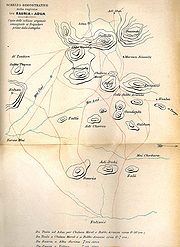
An 1890s Italian map of Adwa, showing Abba Garima and other notable places east of Adwa (the map appears to be facing west)
Abba Garima Monastery is an Ethiopian Orthodox monastery, located some 5 kilometres east of Adwa, in the Mehakelegnaw Zone of the Tigray Region of northern Ethiopia. Founded in the sixth century by one of the Nine Saints, Abbu Garima and built by King Gabra Masqal (also Gebre Meskel), it became known for its tenth century gospels and treasury.[1]
History[]
The namesake of the monastery, Abba Garima is believed to have been a Byzantine royal with healing powers who was summoned to Axum by Abba Pantaleon.[1] King Gabra Masqal built for him a monastery near Adwa, where he lived for some 20 years performing miracles and healing the sick. Above the monastery on a hill is a spring where Abba Garima is said to have spat on the spot and started a life form.[1]
The monastery was attacked twice during its history, once by Queen Gudit in the 10th century and a second time in the 1530s by Imam Ahmad Gragn, a Moslem who attacked the monastery with his Turkish muskets.[2]
The first European recorded to have visited the monastery in modern times was Henry Salt, who visited it on 14 September 1805. He was told at the time that the building had been built by Gabra Masqal in 560.[3]
In around 1872 or 1873, Emperor Tekle Giyorgis II of Ethiopia was blinded, and imprisoned with his brother and mother at the Abba Garima Monastery, where he died or was executed some years later.[4]
In 1896, the monastery proved an important location during the Italian invasion when Menelik II spotted the advancing troops from the monastery, which contributed to his decisive victory over the Italians.[1] Later, in 1897, Ras Alula died at Abba Garima after being wounded in a battle with his old rival, Ras Hagos of Hamasien. His tomb is located at the rear of the main church.[1]
Layout and artifacts[]

The Nine Saints (not all in photo) of the Ethiopian Orthodox Church
The monastery is surrounded by rugged cliffs which are covered with cactus and shrubs. The roofs of the monastery are painted green, and the window frames and doors are painted green, red and yellow.[2] The monastery consists of three churches,[2] about fifteen square and circular cells in which the monks live and a notable treasury. The entrance to the treasury is a stone portal with steps and inside the round building is a glass cabinet as wide as the room. They contain an extensive collection of crowns, helmuts, crosses, chalices and manuscripts[2] and other treasures from the various emperors and religious figures of Ethiopia dating back to the monastery's founder, Gabra Masqal whose silver cross with gold inlays remains, as does the crown of Zara Yaqob (1399–1468).[1] There are also other items such as a pair of cow horns embedded in the wall, and leather bible satchels for the monks to preach in nearby villages.[2]
The library of the monastery is extensive and includes a detailed history of the early history by a priest named Hawi. The most important though is the illuminated Gospel of Abba Garima which is stored in a glass case.[1] According to legend, Abbu Garima himself wrote the gospels on 350 pages on thick goat's vellum in the Ge'ez language and illuminated the first 12 pages on both volumes.[2] However, most outside scholars and scientists have agreed that the gospels, based on his teachings, were written centuries after his death, probably by priests in the tenth century.[1] The book is believed to have taken to India to be published and has been translated into Portugese.[5]
References[]
- ↑ 1.0 1.1 1.2 1.3 1.4 1.5 1.6 1.7 Briggs, Philip (2006). Ethiopia, 4th: The Bradt Travel Guide. Bradt Travel Guides. pp. 262-263. ISBN 1841621285. http://books.google.co.uk/books?id=oPAUxFDrQaQC&pg=PA262&lpg=PA262&dq=Abba+Garima+Monastery&source=bl&ots=m21-I9lPQV&sig=Da9bJX9BKy3-yJpz_bUFMdRMOX0&hl=en&ei=OVXDSt2FDYnE-Qb7sI3vCw&sa=X&oi=book_result&ct=result&resnum=5&ved=0CBQQ6AEwBA#v=onepage&q=Abba%20Garima%20Monastery&f=false.
- ↑ 2.0 2.1 2.2 2.3 2.4 2.5 Winstanley, Mark. "Tsbook (Tigrinya for Good) - The Gospel of Abba Garima". Spring - 2007 - Volume 23. http://www.hewit.com/sd23-tsb.htm. Retrieved September 30, 2009.
- ↑ John J. Halls, Life and Correspondence of Henry Salt, (London, 1834), vol. 1 p. 119
- ↑ Marcus, Harold G. (1995). The Life and Times of Menelik II: Ethiopia 1844-1913. Lawrenceville: Red Sea Press. pp. 35.
- ↑ Böll, Verena. Ethiopia and the missions: historical and anthropological insights. Volume 25 of Afrikanische Studien, LIT Verlag Berlin-Hamburg-Münster. pp. 18. ISBN 3825877922. http://books.google.co.uk/books?id=R3gDX2OolioC&pg=PA18&lpg=PA18&dq=Abba+Garima&source=bl&ots=MeMFgrL15G&sig=A5OF86A7yaXrjWOtYWAlW0d2_QQ&hl=en&ei=hGfDSuGlJ4_r-AbQ3JTvCw&sa=X&oi=book_result&ct=result&resnum=5&ved=0CBUQ6AEwBDgK#v=onepage&q=Abba%20Garima&f=false.